Seat Peugeot 301 2017 Owner's Manual
[x] Cancel search | Manufacturer: PEUGEOT, Model Year: 2017, Model line: 301, Model: Peugeot 301 2017Pages: 306, PDF Size: 9.87 MB
Page 4 of 306
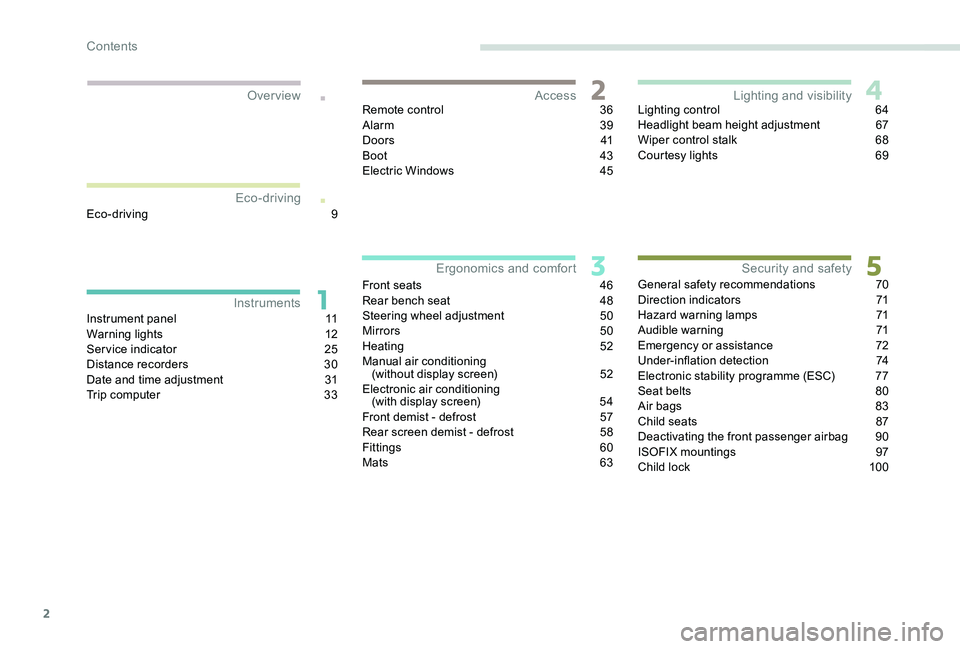
2
.
.
Instrument panel 11
Warning lights 1 2
Service indicator
2
5
Distance recorders
3
0
Date and time adjustment
3
1
Trip computer
3
3Remote control
3
6
Alarm
39
D o o r s
41
Boo
t
43
Electric Windows
4
5
Front seats
4
6
Rear bench seat
4
8
Steering wheel adjustment 5 0
Mirrors 5 0
Heating
52
Manual air conditioning (without display screen)
5
2
Electronic air conditioning (with display screen)
5
4
Front demist - defrost
5
7
Rear screen demist - defrost
5
8
Fittings
6
0
Mats
6
3Lighting control
6
4
Headlight beam height adjustment
6
7
Wiper control stalk
6
8
Courtesy lights
6
9
General safety recommendations
7
0
Direction indicators
7
1
Hazard warning lamps 7 1
Audible warning 7 1
Emergency or assistance
7
2
Under-inflation detection
7
4
Electronic stability programme (ESC)
7
7
Seat belts
8
0
Air bags
8
3
Child seats
87
D
eactivating the front passenger airbag
9
0
ISOFIX mountings
9
7
Child lock
1
00
Eco-driving
9
Eco-driving
Instruments Access
Over view
Ergonomics and comfort Lighting and visibility
Security and safety
Contents
Page 7 of 306
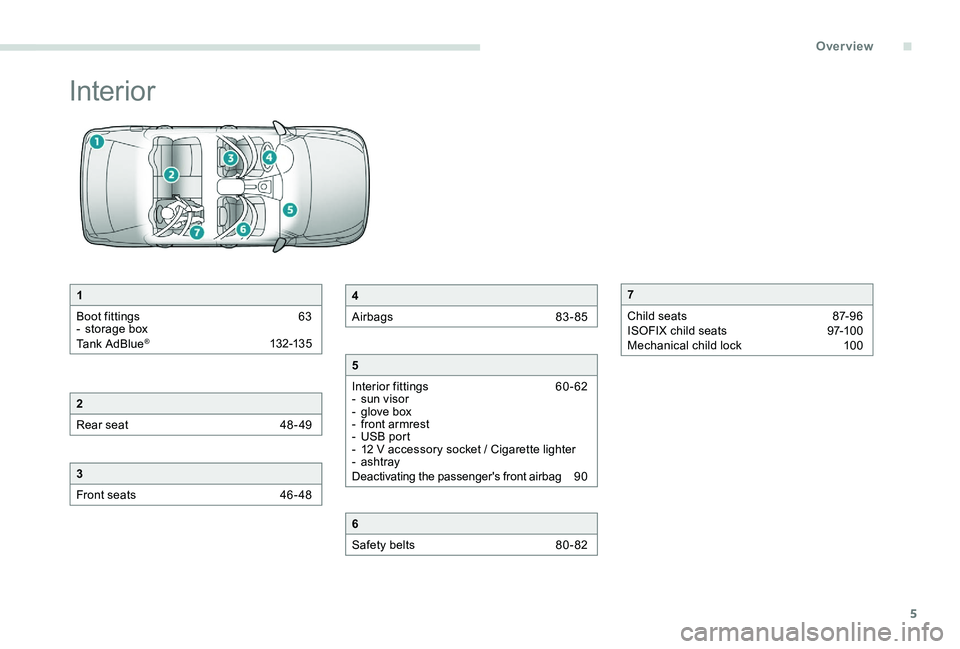
5
Interior
1
Boot fittings
6
3
-
s
torage box
Tank AdBlue
® 132-13 5
2
Rear seat
4
8- 49
3
Front seats
4
6 - 48
4
Airbags
8
3-85
5
Interior fittings
6
0-62
-
s
un visor
-
g
love box
-
f
ront armrest
-
U
SB port
-
1
2 V accessory socket / Cigarette lighter
-
ashtray
Deactivating the passenger's front airbag
9
0
6
Safety belts
8
0-82
7
Child seats
87
-96
ISOFIX child seats
9
7-100
Mechanical child lock
1
00
.
Over view
Page 8 of 306
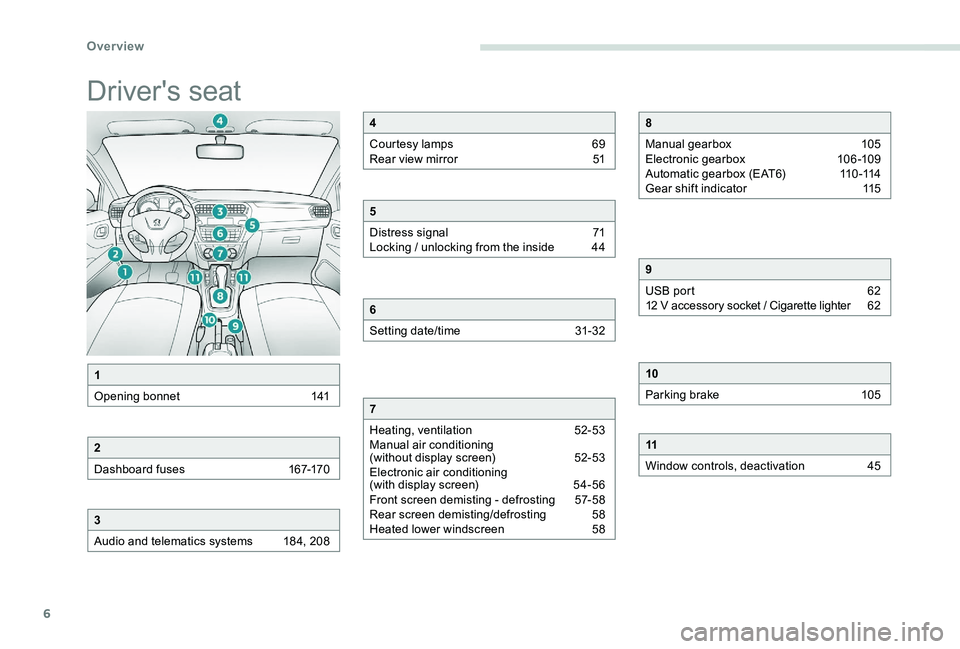
6
Driver's seat
1
Opening bonnet
1
41
2
Dashboard fuses
1
67-170
3
Audio and telematics systems
1
84, 208
4
Courtesy lamps
6
9
Rear view mirror
5
1
5
Distress signal
7
1
Locking / unlocking from the inside
4
4
6
Setting date/time
3
1-32
7
Heating, ventilation
5
2-53
Manual air conditioning
(without display screen)
5
2-53
Electronic air conditioning
(with display screen)
5
4-56
Front screen demisting - defrosting
5
7-58
Rear screen demisting/defrosting
5
8
Heated lower windscreen
5
8
8
Manual gearbox
1
05
Electronic gearbox
1
06-109
Automatic gearbox (EAT6)
1
10 -114
Gear shift indicator
1
15
9
USB port
6
2
12 V accessory socket / Cigarette lighter
6
2
10
Parking brake
1
05
11
Window controls, deactivation
4
5
Over view
Page 9 of 306
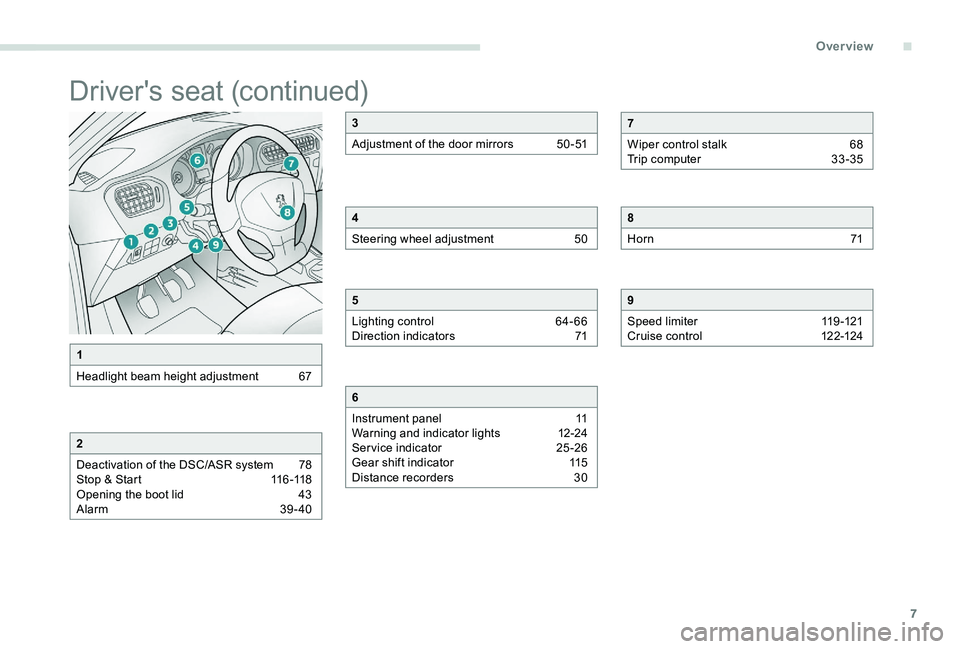
7
Driver's seat (continued)
1
Headlight beam height adjustment
6
7
2
Deactivation of the DSC/ASR system
7
8
Stop & Start
1
16 -118
Opening the boot lid
4
3
Alarm
3
9- 40
3
Adjustment of the door mirrors
5
0 -51
4
Steering wheel adjustment
5
0
5
Lighting control
6
4-66
Direction indicators
7
1
6
Instrument panel
1
1
Warning and indicator lights
1
2-24
Service indicator
2
5-26
Gear shift indicator
1
15
Distance recorders
3
0
7
Wiper control stalk
6
8
Trip computer
3
3 -35
8
H o r n
71
9
Speed limiter
1
19-121
Cr uise c ontrol
12
2-124
.
Over view
Page 11 of 306
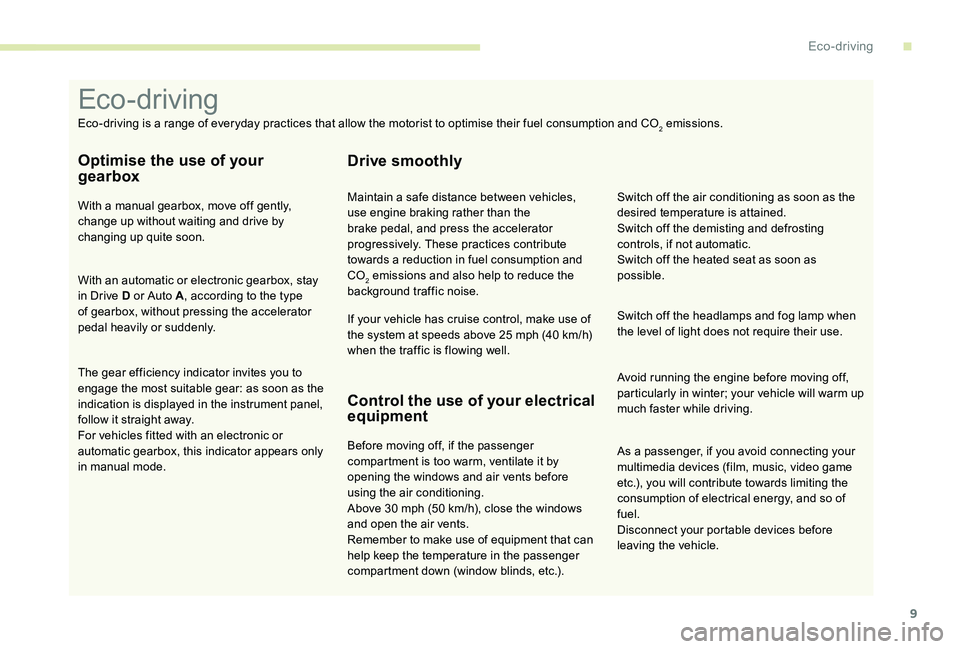
9
As a passenger, if you avoid connecting your
multimedia devices (film, music, video game
etc.), you will contribute towards limiting the
consumption of electrical energy, and so of
fuel.
Disconnect your portable devices before
leaving the vehicle.
Eco-driving
Eco-driving is a range of everyday practices that allow the motorist to optimise their fuel consumption and CO2 emissions.
Optimise the use of your
gearbox
With a manual gearbox, move off gently,
change up without waiting and drive by
changing up quite soon.
With an automatic or electronic gearbox, stay
in Drive D or Auto A, according to the type
of gearbox, without pressing the accelerator
pedal heavily or suddenly.
The gear efficiency indicator invites you to
engage the most suitable gear: as soon as the
indication is displayed in the instrument panel,
follow it straight away.
For vehicles fitted with an electronic or
automatic gearbox, this indicator appears only
in manual mode.
Drive smoothly
Maintain a safe distance between vehicles,
use engine braking rather than the
brake pedal, and press the accelerator
progressively. These practices contribute
towards a reduction in fuel consumption and
CO
2 emissions and also help to reduce the
background traffic noise.
If your vehicle has cruise control, make use of
the system at speeds above 25 mph (40 km/h)
when the traffic is flowing well.
Control the use of your electrical
equipment
Before moving off, if the passenger
compartment is too warm, ventilate it by
opening the windows and air vents before
using the air conditioning.
Above 30 mph (50 km/h), close the windows
and open the air vents.
Remember to make use of equipment that can
help keep the temperature in the passenger
compartment down (window blinds, etc.). Switch off the headlamps and fog lamp when
the level of light does not require their use.
Avoid running the engine before moving off,
particularly in winter; your vehicle will warm up
much faster while driving. Switch off the air conditioning as soon as the
desired temperature is attained.
Switch off the demisting and defrosting
controls, if not automatic.
Switch off the heated seat as soon as
possible.
.
Eco-driving
Page 12 of 306
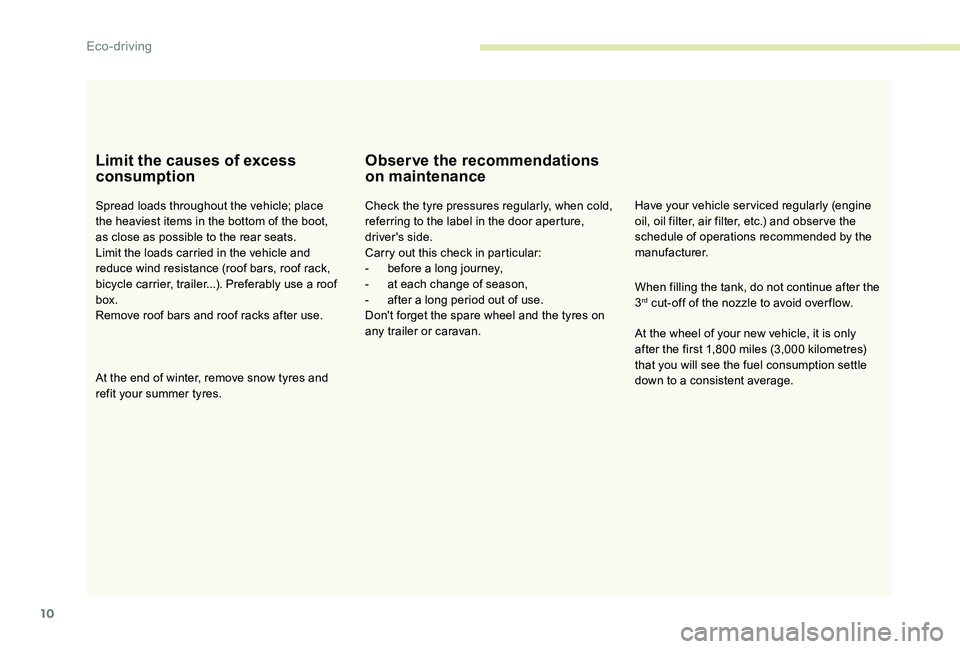
10
Limit the causes of excess
consumption
Spread loads throughout the vehicle; place
the heaviest items in the bottom of the boot,
as close as possible to the rear seats.
Limit the loads carried in the vehicle and
reduce wind resistance (roof bars, roof rack,
bicycle carrier, trailer...). Preferably use a roof
box.
Remove roof bars and roof racks after use.
At the end of winter, remove snow tyres and
refit your summer tyres.
Observe the recommendations
on maintenance
Check the tyre pressures regularly, when cold,
referring to the label in the door aperture,
driver's side.
Carry out this check in particular:
-
b
efore a long journey,
-
a
t each change of season,
-
a
fter a long period out of use.
Don't forget the spare wheel and the tyres on
any trailer or caravan. Have your vehicle serviced regularly (engine
oil, oil filter, air filter, etc.) and observe the
schedule of operations recommended by the
manufacturer.
When filling the tank, do not continue after the
3
rd cut-off of the nozzle to avoid over flow.
At the wheel of your new vehicle, it is only
after the first 1,800 miles (3,000 kilometres)
that you will see the fuel consumption settle
down to a consistent average.
Eco-driving
Page 16 of 306
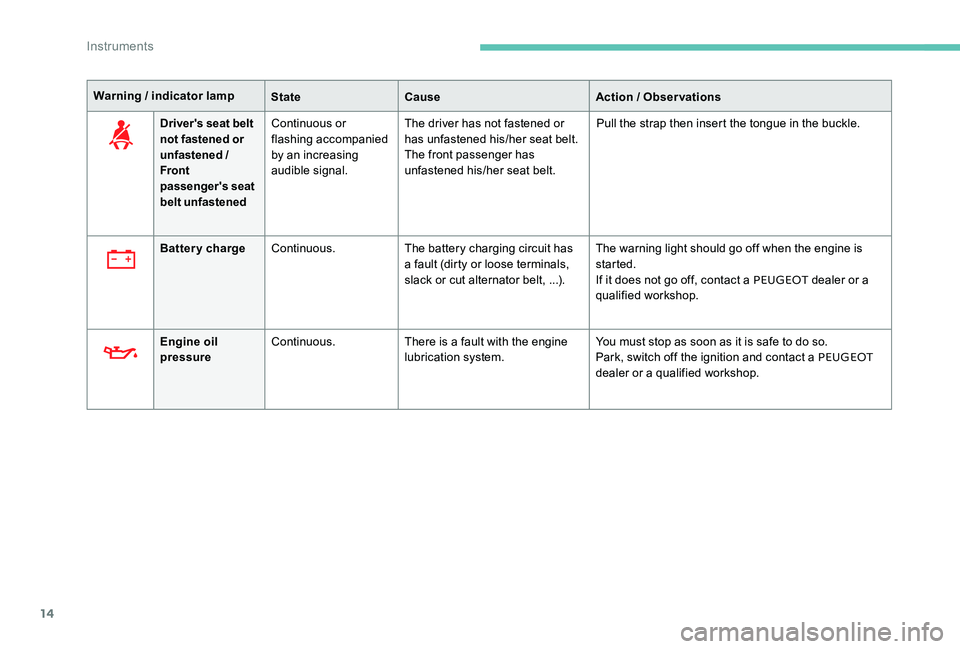
14
Warning / indicator lampStateCause Action / Observations
Driver's seat belt
not fastened or
unfastened /
Front
passenger's seat
belt unfastened Continuous or
flashing accompanied
by an increasing
audible signal.
The driver has not fastened or
has unfastened his/her seat belt.
The front passenger has
unfastened his/her seat belt. Pull the strap then insert the tongue in the buckle.
Battery charge Continuous. The battery charging circuit has
a fault (dirty or loose terminals,
slack or cut alternator belt, ...). The warning light should go off when the engine is
started.
If it does not go off, contact a PEUGEOT
dealer or a
qualified workshop.
Engine oil
pressure Continuous.
There is a fault with the engine
lubrication system. You must stop as soon as it is safe to do so.
Park, switch off the ignition and contact a PEUGEOT
dealer or a qualified workshop.
Instruments
Page 20 of 306
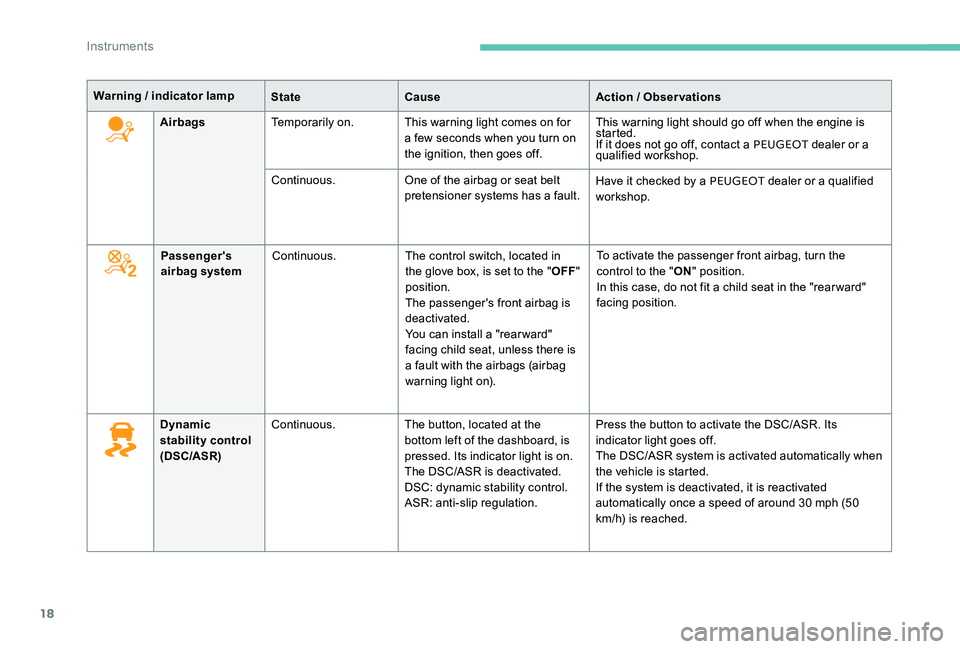
18
Warning / indicator lampStateCause Action / Observations
Airbags Temporarily on. This warning light comes on for
a few seconds when you turn on
the ignition, then goes off. This warning light should go off when the engine is
started.
If it does not go off, contact a PEUGEOT
dealer or a
qualified workshop.
Continuous. One of the airbag or seat belt
pretensioner systems has a fault. Have it checked by a PEUGEOT
dealer or a qualified
workshop.
Passenger's
airbag system Continuous.
The control switch, located in
the glove box, is set to the " OFF"
position.
The passenger's front airbag is
deactivated.
You can install a "rearward"
facing child seat, unless there is
a fault with the airbags (airbag
warning light on). To activate the passenger front airbag, turn the
control to the "
ON" position.
In this case, do not fit a child seat in the "rear ward"
facing position.
Dynamic
stability control
(DSC/ASR) Continuous.
The button, located at the
bottom left of the dashboard, is
pressed. Its indicator light is on.
The DSC/ASR is deactivated.
DSC: dynamic stability control.
ASR: anti-slip regulation. Press the button to activate the DSC/ASR. Its
indicator light goes off.
The DSC/ASR system is activated automatically when
the vehicle is started.
If the system is deactivated, it is reactivated
automatically once a speed of around 30 mph (50
km/h) is reached.
Instruments
Page 46 of 306
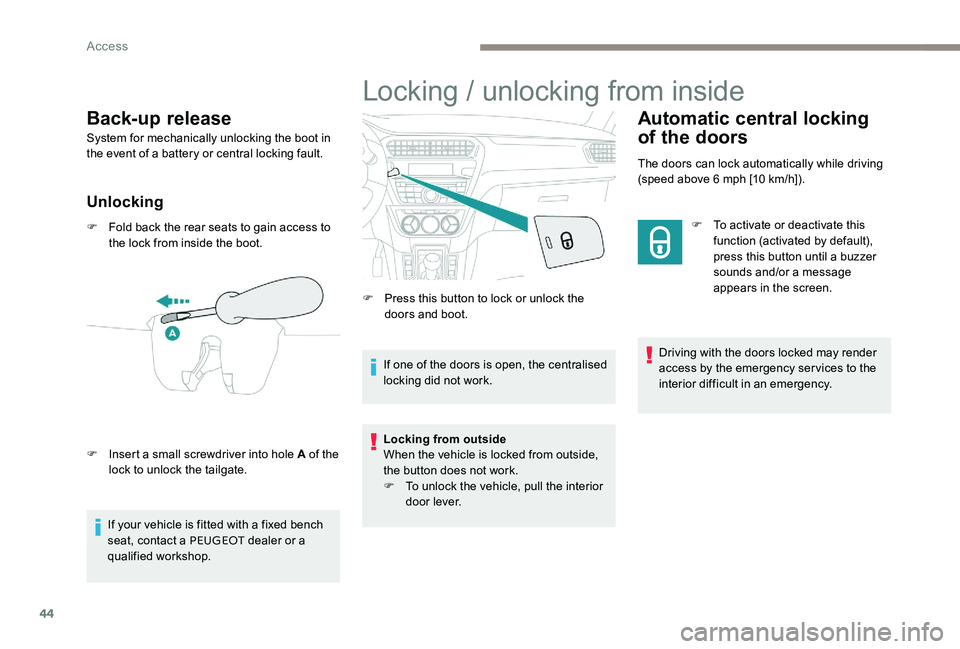
44
Back-up release
System for mechanically unlocking the boot in
the event of a battery or central locking fault.
Unlocking
F Fold back the rear seats to gain access to the lock from inside the boot.
F
I
nsert a small screwdriver into hole A of the
lock to unlock the tailgate.
If your vehicle is fitted with a fixed bench
seat, contact a PEUGEOT dealer or a
qualified workshop.
Locking / unlocking from inside
F Press this button to lock or unlock the doors and boot.
If one of the doors is open, the centralised
locking did not work.
Locking from outside
When the vehicle is locked from outside,
the button does not work.
F
T
o unlock the vehicle, pull the interior
door lever.
Automatic central locking
of the doors
The doors can lock automatically while driving
(speed above 6 mph [10 km/h]).
Driving with the doors locked may render
access by the emergency services to the
interior difficult in an emergency. F
T
o activate or deactivate this
function (activated by default),
press this button until a buzzer
sounds and/or a message
appears in the screen.
Access
Page 48 of 306
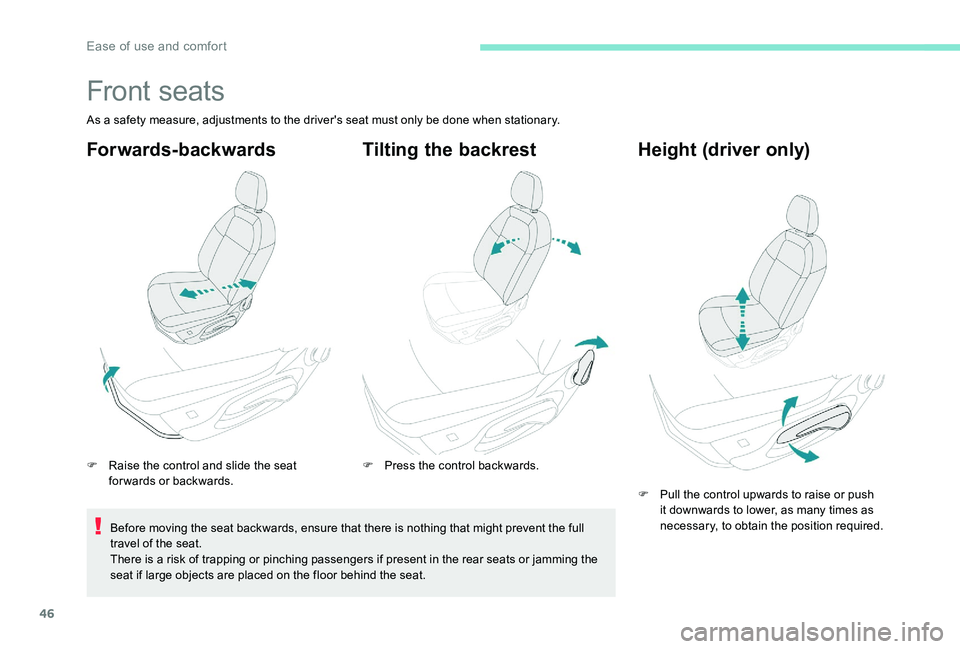
46
Front seats
As a safety measure, adjustments to the driver's seat must only be done when stationary.
Forwards-backwards
F Raise the control and slide the seat forwards or backwards.
Before moving the seat backwards, ensure that there is nothing that might prevent the full
travel of the seat.
There is a risk of trapping or pinching passengers if present in the rear seats or jamming the
seat if large objects are placed on the floor behind the seat.
Tilting the backrest
F Press the control backwards.
Height (driver only)
F Pull the control upwards to raise or push it downwards to lower, as many times as
necessary, to obtain the position required.
Ease of use and comfort